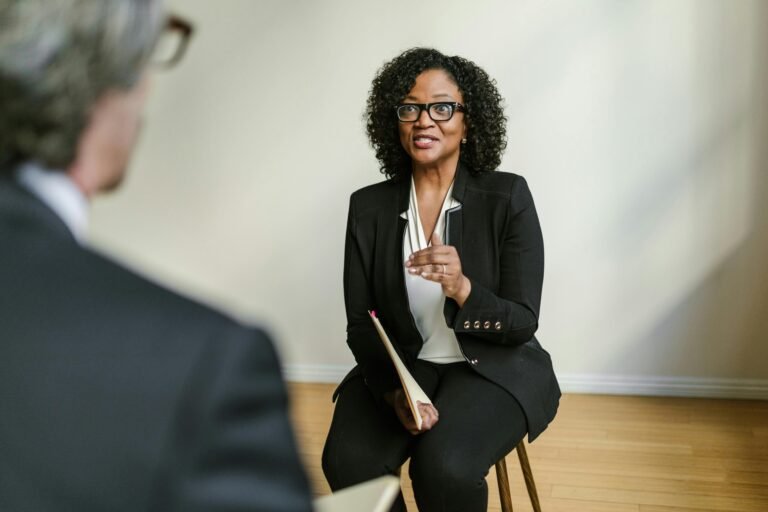If you’re interviewing for a K–12 school position virtually, whether it’s a teaching, leadership, or support role, you may be focusing on the words you plan to say. But here’s something just as important: your body language and how you show up through the screen.
Your tone of voice, facial expressions, posture, and gestures all work together to communicate your confidence, professionalism, personality, and leave a lasting impression. In a virtual setting, where interviewers can only see a small part of you, these cues carry even more weight. And while virtual interviews might seem less personal, they’re a real opportunity to shine, if you approach them with intention.
In this article, we’ll explore 10 body language tips that can help you build connection, stay grounded, and come across as your best self on camera. We’ll also share one key strategy to improve your skills that many candidates overlook: recording yourself ahead of time. (More on that soon.)
Body Language Tips to Boost Your Virtual Interview Presence
1. Frame Yourself Like a Professional
What it looks like: Your head, shoulders, and upper chest are clearly visible, centered in the screen. Your eyes are roughly one-third from the top of the frame, and you’re not looking up or down into the camera.
Why it matters: Poor framing—like being too far back or having half your head cut off—can distract from your message. Proper framing instantly makes you appear more professional and engaged.
Pro tip: Use a laptop stand or books to raise your webcam to eye level. Avoid sitting too close, which can feel intense, or too far, which can seem disengaged.
2. Use Lighting That Supports (Not Shadows) You
What it looks like: Soft, front-facing light brightens your face and minimizes harsh shadows. Ideally, you’re facing a window or using a ring light—not sitting with bright light behind you.
Why it matters: Lighting influences how clearly your facial expressions come across. If you’re too dimly lit, it can be hard to read your emotions or make eye contact.
Quick fix: If natural light isn’t available, angle a desk lamp behind your computer (not above or behind you).
3. Sit with Purpose and Presence
What it looks like: You’re sitting upright with your feet planted and your back supported. Your posture is open and relaxed, not rigid or slouched.
Why it matters: Good posture helps you project confidence and remain attentive. It also helps your voice come through stronger and clearer.
Tip: Avoid rolling chairs or couches. Choose a sturdy, comfortable seat that helps you stay focused.
4. Look at the Camera and Not Your Own Image
What it looks like: When you’re speaking, your gaze is directed at the camera. When you’re listening, it’s okay to look at your screen, but try to maintain eye contact regularly.
Why it matters: Eye contact (even virtual) builds trust. Looking into the camera simulates eye contact and helps the interviewer feel more connected to you.
Practice move: Stick a small reminder near your webcam—like a smiley face—to help you remember to look up.
5. Smile Genuinely (Not Constantly)
What it looks like: A warm, natural smile at key moments—like during your introduction, when sharing something you’re excited about, or as the conversation wraps up.
Why it matters: Smiling conveys warmth and approachability. It also helps you appear relaxed and confident, even if you’re nervous inside.
Tip: Smile as you greet the interviewer, when discussing your passion for the work, and during your thank you.
6. Use Hand Gestures Thoughtfully
What it looks like: Your hands occasionally come into frame to support your words—pointing, opening palms, or gesturing to illustrate a point—but not waving or fidgeting constantly.
Why it matters: Natural gestures help you appear animated and authentic. Overuse, though, can be distracting.
Anchor technique: Rest your hands gently on the desk when not gesturing to avoid over-movement.
7. Practice Subtle Head Nods and Reactions
What it looks like: As the interviewer speaks, you nod occasionally, raise your eyebrows to show interest, or smile in response.
Why it matters: These small cues show that you’re listening and engaged, even in moments when you’re not speaking.
Note: If your screen freezes and you’re still reacting with body language, it can help maintain rapport until the connection resumes.
8. Try to Avoid Fidgeting or Self-Soothing Habits
What it looks like: You’re not adjusting your hair constantly, tapping a pen, or swiveling in your chair.
Why it matters: Nervous habits draw focus away from your message. They can signal discomfort or uncertainty, even if you’re well-prepared.
Solution: Record yourself during a mock interview (see below!) to identify and address subtle habits.
9. Close the Interview with Strong Nonverbal Cues
What it looks like: You smile, make eye contact, and thank the interviewer sincerely. You stay engaged until the meeting ends, without scrambling to leave the call.
Why it matters: Your goodbye moment is often what lingers most. Leave with warmth and professionalism.
Tip: Stay on camera until the meeting fully ends, even if the interviewer starts wrapping up. Maintain composure through the final wave or goodbye.
10. Practice by Recording Yourself First
What it looks like: You use your phone or video software to record a practice run of your responses. Then, you watch it back—not to judge yourself, but to notice your body language, pacing, and presence.
Why it matters: What you feel internally doesn’t always match what others see externally. Recording yourself helps you identify things like speaking too fast, looking away too often, or fidgeting.
Are you looking for guidance on this? We created a full article on how to record and review yourself for interview prep, packed with tips to build confidence and refine your delivery.
In Closing: Small Shifts, Big Impact
Virtual interviews may feel less formal than in-person ones, but your body language still matters, a lot. The good news is that you can practice and improve. Small tweaks to how you sit, look, move, and respond can go a long way in helping you feel (and appear) calm, confident, and ready.
The most important thing is to be you, present, prepared, and fully in the moment. When your body language supports your message, you’ll leave a lasting impression, no matter where the interview takes place.
Good luck on your upcoming interview!
Related Posts
What to Say and What Not to Say About a Previous Employer
How to Conduct a Self-Assessment to Identify Your Strengths and Weaknesses
Why You Should Never Criticize a Former Employer During a Job Interview
5 Strategies for Turning a Negative Job Experience into a Positive Interview Discussion









